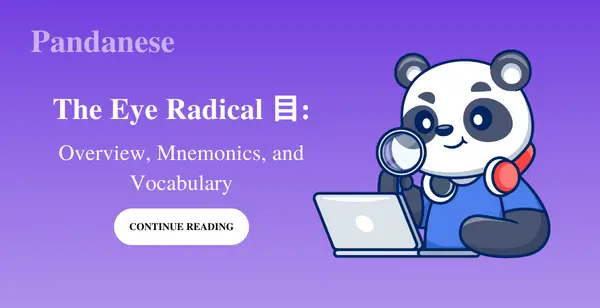
The Eye Radical 目: Overview, Mnemonics, and Vocabulary
Today, we’ll introduce to you a radical related to our body parts in Chinese. “What body part is pronounced as one letter but written with three, only two different letters are used?”
“Did you figure it out yet? Is it the head? No! Is it the forehead? Not even close! But you’re almost there, going down just a bit. Ah, it’s the eyes, isn’t it? One point for you guys! It’s “eye.”
We’ll introduce the eye radical, what it is, and how to memorize it with fun mnemonics.
What is the eye radical?

The Chinese eye radical is pronounced as “mù” and written as 目. This radical is composed of 5 strokes and listed as radical 109 according to the Kangxi radical chart (a system of radicals of Chinese characters). 目 mù is one of the most widely used radicals, with 674 characters (out of 49,030) found under this radical in the Kangxi Dictionary.
Eye radical 目 mù is a pictogram character that conveys a message or an idea using representational or pictorial drawings. Similar to other radicals such as 一 yī (one), 口 kǒu (mouth), or 厂 hǎn(cliff), the eye radical 目 mù also shows how the character and the object they describe are closely related.
Let’s take a look at how this radical transformed through time:

What is the stroke order of the radical 目?
The eye radical 目 has five strokes, written in the following stroke order:

How can you memorize the eye radical?
Need help with memorizing the eye radical? Here is a mnemonic to help you out: This radical means and looks like an eye. People born with two different colored eyes have a condition called heterochromia. Pretty neat, eh?
To remember the Chinese character pronunciation, here is another mnemonic: Make-up artists for movies (mù) can transform people simply with eye make-up.
Memorizing Chinese hanzi can be difficult but with Chinese mnemonics, it can make it easier. Combine mnemonics with SRS, then it is a match made in heaven to remember complex Chinese characters. That’s where Pandanese comes in. Pandanese has these two aspects for you to get the most out of your learning.
Eye radical vocabulary list for you!
Want to explore more about the eye radical and other related terms? Enrich your knowledge with this vocabulary list.
Character |
Pinyin |
English meaning |
看 |
kàn |
watch, look |
睡 |
shuì |
sleep |
冒 |
mào |
emit |
眼睛 |
yǎn jing |
eyes |
眉毛 |
méimao |
eyebrow |
一 眼 |
yīyǎn |
a glance |
节目 |
jiémù |
performance, show |
目的 |
mùdì |
purpose |
目前 |
mùqián |
at the present time |
目光 |
mùguāng |
gaze |
注目 |
zhùmù |
attention |
In closing
Breaking down complex Chinese characters into their simple forms will help you see how the components create the meaning. The eye radical is included in this list. Seeing the eye radical will give you an insight into the meaning related to vision, perception, or observation.
The easiest way to learn Chinese & build vocabulary

